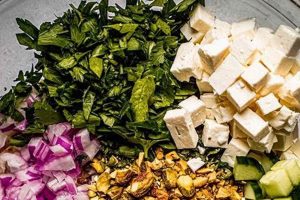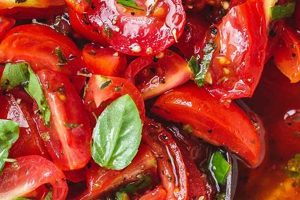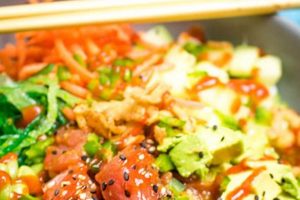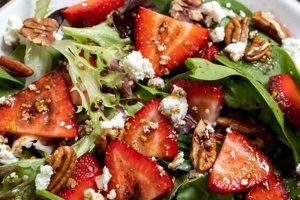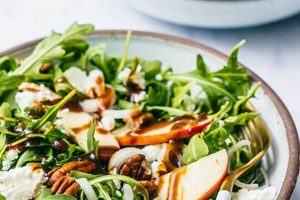This refreshing dish typically combines cranberries, often fresh or dried and rehydrated, with crushed pineapple. The sweetness of the pineapple complements the tartness of the cranberries, creating a balanced flavor profile. Other common ingredients include nuts, such as pecans or walnuts, and sometimes marshmallows or cream cheese, adding textural variety and richness. Variations might incorporate orange zest, ginger, or other fruits, offering further flavor complexity.
The vibrant colors and contrasting flavors make this salad a popular side dish, particularly during holidays like Thanksgiving and Christmas. Its relatively simple preparation and adaptability to different tastes contribute to its widespread appeal. The combination of fruit and nuts offers nutritional benefits, including vitamins, antioxidants, and healthy fats. Historically, recipes featuring cranberries and pineapple arose alongside increased availability of canned pineapple in the early 20th century, expanding culinary possibilities and introducing new flavor combinations to traditional cuisine.
The following sections will explore specific ingredient combinations, preparation methods, and variations of this festive salad, offering guidance for creating both classic and innovative versions.
Tips for a Perfect Cranberry Salad
Achieving the ideal balance of flavor and texture in a cranberry salad requires attention to detail. The following tips offer guidance for optimizing ingredients and preparation techniques.
Tip 1: Cranberry Selection: Fresh cranberries offer a vibrant tartness, while dried cranberries provide a chewier texture and concentrated sweetness. Rehydrate dried cranberries briefly before use to plump them.
Tip 2: Pineapple Preparation: Well-drained crushed pineapple is crucial to prevent a watery salad. Consider using pineapple tidbits for a more substantial texture.
Tip 3: Balancing Sweetness: Adjust the sweetness level by adding a small amount of sugar or a touch of orange juice, depending on the sweetness of the pineapple and other ingredients.
Tip 4: Nut Selection and Preparation: Toasted nuts enhance flavor. Pecans and walnuts are classic choices, but consider almonds or macadamia nuts for variation. Coarsely chop nuts for optimal texture.
Tip 5: Binding Agents: Traditional recipes often include a creamy element such as mayonnaise, whipped cream, or cream cheese. For a lighter version, use Greek yogurt or a reduced-fat cream cheese.
Tip 6: Flavor Enhancement: Orange zest, grated ginger, or a pinch of cinnamon can add depth and complexity to the flavor profile.
Tip 7: Chilling Time: Allow the salad to chill for at least two hours before serving. This allows the flavors to meld and the salad to firm up.
By following these tips, one can create a cranberry salad that offers a delightful combination of flavors and textures, complementing any meal.
These guidelines offer a starting point for creating a personalized version of this classic dish. Experimentation with ingredients and preparation techniques can lead to exciting culinary discoveries.
1. Ingredients
Ingredient selection is paramount in determining the overall character of a cranberry salad. Each component contributes not only to the flavor profile but also to the texture and visual appeal. Careful consideration of these elements ensures a balanced and satisfying final product.
- Cranberries:
The foundation of this salad, cranberries provide a distinctive tartness. Fresh cranberries offer a bright, slightly acidic flavor and firm texture. Dried cranberries, while sweeter and chewier, provide a concentrated flavor and contribute to shelf stability. The choice between fresh and dried impacts both taste and texture.
- Pineapple:
Crushed pineapple introduces sweetness and a tropical touch. Its juicy character complements the tart cranberries. Proper draining is crucial to prevent excess moisture in the salad. The sweetness level of the pineapple influences the overall balance, potentially requiring adjustments in other ingredients.
- Nuts:
Nuts introduce textural contrast and richness. Pecans and walnuts are traditional choices, offering a buttery flavor and satisfying crunch. Other options, such as almonds or macadamia nuts, provide alternative flavor profiles and textures. Toasting the nuts enhances their flavor and crispness.
- Binding Agent:
A creamy element binds the ingredients and adds richness. Mayonnaise, whipped cream, or cream cheese are common choices. For a lighter alternative, Greek yogurt or reduced-fat cream cheese can be used. The binding agent significantly impacts the overall texture and richness of the salad.
The interplay of these ingredients defines the final product. The tartness of cranberries, sweetness of pineapple, richness of nuts, and creaminess of the binding agent create a complex flavor profile and satisfying textural experience. The selection and proportion of each ingredient allow for customization and adaptation to individual preferences, ensuring a truly personalized culinary creation.
2. Preparation
Preparation significantly influences the final quality of a cranberry salad. Methodical execution of each step ensures optimal flavor development, texture, and overall appeal. Consideration of ingredient preparation, combining techniques, and chilling time contributes to a successful outcome.
Cranberry preparation varies depending on whether fresh or dried cranberries are used. Fresh cranberries require rinsing and potential chopping, depending on desired texture. Dried cranberries benefit from brief rehydration in warm water or juice to restore plumpness. Pineapple preparation emphasizes thorough draining to prevent excess liquid in the salad. Nuts achieve optimal flavor and texture through toasting and chopping. Combining ingredients gently prevents crushing delicate components and maintains structural integrity. The choice of binding agent influences the mixing process, impacting the final texture and consistency.
For example, overmixing a salad with a mayonnaise-based dressing can lead to a dense, less appealing texture. Conversely, insufficient chilling time prevents flavors from melding and may result in a less cohesive dish. Adequate chilling allows flavors to deepen and the salad to firm, resulting in a more balanced and enjoyable culinary experience. Careful attention to preparation transforms individual ingredients into a harmonious, flavorful, and visually appealing cranberry salad.
3. Flavor Balance
Flavor balance is crucial for a successful cranberry salad. The interplay of tartness, sweetness, and richness defines the overall sensory experience. A well-balanced salad features complementary flavors that enhance, rather than overpower, each other. Understanding the individual flavor contributions of each ingredient allows for precise adjustments and a harmonious final product.
- Tartness
Cranberries provide the foundational tartness. This tartness, derived from their natural acidity, serves as a counterpoint to other flavors. The intensity of tartness can be adjusted by choosing fresh versus dried cranberries or incorporating other tart ingredients such as orange zest. Proper balance prevents the salad from becoming overly acidic while still maintaining a refreshing quality.
- Sweetness
Crushed pineapple contributes the primary sweetness. The natural sugars in pineapple balance the cranberry’s tartness. The sweetness level can be further adjusted with a small amount of added sugar or a touch of orange juice, depending on the sweetness of the pineapple itself. Achieving the right level of sweetness prevents the salad from being overly tart or cloyingly sweet.
- Richness
Nuts, often pecans or walnuts, add richness and depth. Their buttery flavor and fat content contribute to a more complex flavor profile. Toasting the nuts intensifies this richness. The amount of nuts used influences the overall richness of the salad, requiring careful consideration for a balanced outcome.
- Creaminess (Binding Agent)
The binding agent, whether mayonnaise, whipped cream, or cream cheese, contributes a creamy texture and mouthfeel. This creaminess further balances the tartness and sweetness, creating a more rounded flavor experience. The choice of binding agent and its proportion influence the overall richness and texture, requiring careful consideration for balanced results.
The interplay of these flavor elements defines the final character of the cranberry salad. A harmonious balance of tartness, sweetness, richness, and creaminess results in a more complex and satisfying sensory experience. Skilled manipulation of these elements allows for customization and creation of unique flavor profiles, transforming a simple combination of ingredients into a delightful culinary creation.
4. Texture
Texture plays a vital role in the overall appeal of a cranberry salad. The interplay of contrasting textures creates a more engaging and satisfying sensory experience. The combination of smooth, chewy, and crunchy elements elevates this dish beyond a simple mix of ingredients. Consideration of textural variety transforms the salad into a multi-dimensional culinary creation. Several factors contribute to textural complexity.
Cranberries, whether fresh or dried, provide a foundational textural element. Fresh cranberries offer a firm, slightly tart bite, while dried cranberries contribute a chewier consistency. The choice between fresh and dried cranberries significantly influences the overall texture. Crushed pineapple introduces a juicy, soft component. Well-drained pineapple prevents excess moisture, maintaining textural integrity. Nuts, such as pecans or walnuts, introduce a crucial element of crunch. Toasting the nuts enhances their crispness, providing a satisfying contrast to the softer elements. The size of the nut pieces further influences the textural experience. Coarsely chopped nuts offer a more substantial crunch, while finely chopped nuts provide a gentler textural contrast. The binding agent, often mayonnaise, whipped cream, or cream cheese, adds a smooth, creamy element that coats the other ingredients and contributes to the overall mouthfeel.
The balance of these textural components is essential. A successful cranberry salad avoids uniformity and embraces contrast. Too much chewiness, for instance, can result in a dense and less appealing texture. Conversely, an absence of crunch diminishes the dynamic interplay of textures. Careful consideration of ingredient selection and preparation techniques allows for precise control over the final textural profile. This understanding empowers culinary experimentation and enables creation of a cranberry salad that offers not only a delightful flavor profile but also a satisfying textural experience.
5. Presentation
Presentation elevates cranberry salad with crushed pineapple from a simple side dish to a visually appealing culinary creation. Thoughtful presentation enhances the dining experience, stimulating appetite and conveying care in preparation. Visual appeal significantly influences perception of flavor and overall enjoyment. A well-presented salad complements the flavors and textures, creating a more holistic and satisfying sensory experience.
Several factors contribute to effective presentation. The serving vessel plays a significant role. A clear glass bowl showcases the vibrant colors of the cranberries and pineapple. A vintage serving dish adds a touch of elegance. For a festive occasion, a hollowed-out pineapple half provides a dramatic and thematic presentation. Garnishes further enhance visual appeal. Fresh mint sprigs offer a contrasting color and aromatic element. Candied cranberries or pineapple wedges add textural and visual interest. Toasted nuts, scattered around the base of the serving dish, provide a complementary color and texture. Attention to detail, such as ensuring even distribution of ingredients and avoiding overcrowding the serving dish, contributes to a polished and professional appearance.
Effective presentation requires consideration of the context. A casual weeknight dinner might call for a simple presentation in a serving bowl, while a holiday gathering might warrant a more elaborate display. Adapting the presentation to the occasion enhances the overall dining experience. The effort invested in presentation reflects a commitment to culinary excellence, transforming a simple cranberry salad into a memorable element of any meal.
Frequently Asked Questions
This section addresses common inquiries regarding cranberry salad with crushed pineapple, offering clarity and guidance for optimal preparation and enjoyment.
Question 1: Can frozen cranberries be used in this salad?
While fresh cranberries are preferred for their vibrant texture and flavor, frozen cranberries can be substituted. Thaw and drain them thoroughly before incorporating them into the salad to prevent excess moisture.
Question 2: How can one reduce the sweetness of the salad if the pineapple is overly sweet?
Balance excessive sweetness by incorporating a tart element such as orange zest or a small amount of lemon juice. Adjusting the quantity of added sugar, if any, can also help achieve the desired balance.
Question 3: What are suitable alternatives to mayonnaise or cream cheese as a binding agent?
Greek yogurt or reduced-fat cream cheese offer lighter alternatives to traditional mayonnaise or full-fat cream cheese. These options reduce overall fat content while maintaining a creamy texture.
Question 4: How long can cranberry salad with crushed pineapple be stored in the refrigerator?
Properly stored in an airtight container, the salad can be refrigerated for up to three days. However, optimal flavor and texture are best enjoyed within the first two days.
Question 5: Can this salad be prepared in advance for a large gathering?
Preparing the salad a day in advance allows flavors to meld. Store the salad without nuts and add them just before serving to maintain their crisp texture.
Question 6: How can one prevent the salad from becoming watery?
Thoroughly draining the crushed pineapple is crucial to prevent excess moisture. Ensure other ingredients, such as fresh cranberries, are also dry before combining them.
Careful consideration of these frequently asked questions ensures successful preparation and enjoyment of cranberry salad with crushed pineapple. Understanding ingredient selection, preparation techniques, and storage guidelines contributes to a satisfying culinary experience.
Exploring variations on this classic recipe offers further culinary opportunities. The following section delves into creative adaptations and flavor combinations.
Cranberry Salad Recipe with Crushed Pineapple
Exploration of this vibrant dish reveals a balance of tart cranberries and sweet crushed pineapple, complemented by textural elements like nuts and a creamy binding agent. Ingredient selection, preparation techniques, and attention to flavor and textural balance contribute significantly to the final product. Understanding these aspects allows for adaptation and personalization, creating unique variations on the classic recipe. Presentation elevates the dish, transforming it into a visually appealing culinary creation. Proper storage ensures optimal enjoyment and preservation of flavor.
The enduring popularity of cranberry salad with crushed pineapple underscores its adaptability and timeless appeal. Continued exploration of flavor combinations and presentation techniques offers endless possibilities for culinary innovation. This dish exemplifies the transformative power of culinary creativity, demonstrating how simple ingredients, when combined with thoughtful preparation, can create a memorable and satisfying dining experience.

